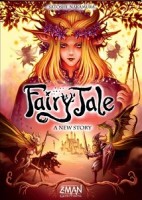
Fairy Tale
Overview
Fairy Tale is a fast and simple card game of card drafting, instant card effects, and scoring combos. Over the course of four rounds, draft cards that you believe will score you the most points. Play cards to foil other players’ scoring opportunities while attempting to keep your cards in play to create your scoring combinations. The player with the most points after four rounds is the winner.
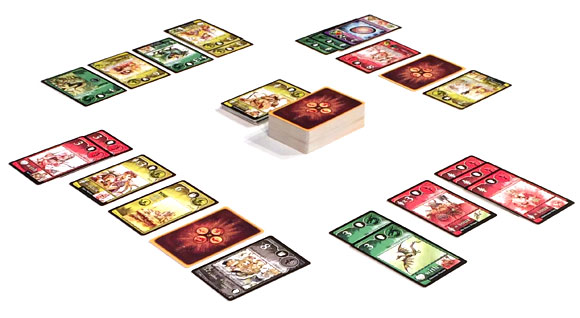
Gameplay
To begin, shuffle the deck of 110 cards and place it in the middle of the table. And that’s set up! Fairy Tale is played in a series of four rounds. Each round has two major stages: the Drafting phase and the Card Play phase.
Drafting Phase
Deal five cards to each player face down. Then, when all are ready, pick up your hand and choose one (and only one) of the cards. Place it face down in front of you and pass the remaining four cards to the player on your left. Repeat this draft until five cards are drafted into a pile in front of each player. You can look at the cards you drafted at any time.
Card Play Phase
In this phase players will play only three of the five cards that they drafted. Pick up your hand of five cards. All players choose one card to play and place it face down in front of them. Then all players simultaneously reveal their cards and play them face up in front of them. Card effects will then happen simultaneously. After all card effects have resolved, play two more cards in the same manner. So after one round all players will have three cards “played” in front of them. The two cards you did not play are placed in a central discard pile.
Repeat these two stages three more times – for a total of four rounds. After which all players score their cards the player with the highest point total wins!
Wait! What about the cards?
All of the action in the game happens when cards are revealed and effects trigger. The cards used in Fairy Tale come in four colors or Factions: Fairywood, Dragonvale, Holy Empire and the Shadow.
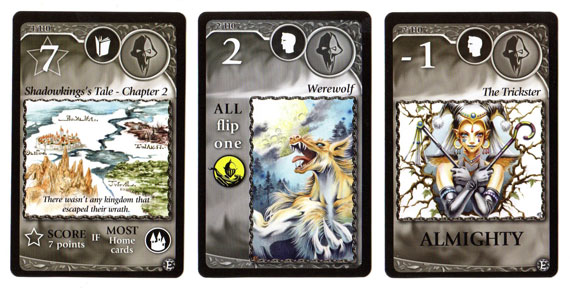
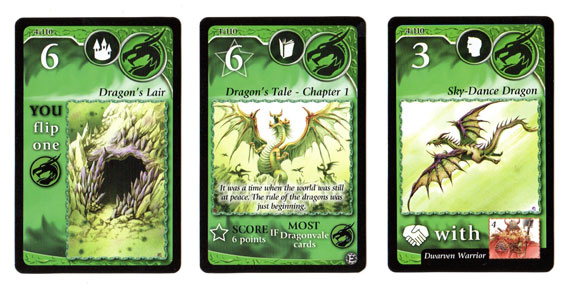
Every card has a name, a category icon (Character, Story or Home), the effect or Power the card has when played (if any) and most importantly, the card’s point value in the upper left hand corner. Two major effects of some cards call for you to “Flip” a card of a certain type when revealed, (turn face down) or “Unflip” a card or cards (turn them face up). YOU can choose any valid card in play, yours or your opponents’. Face down cards don’t score any points in the final round. So, turning your opponents’ cards face down is preferred… well usually.
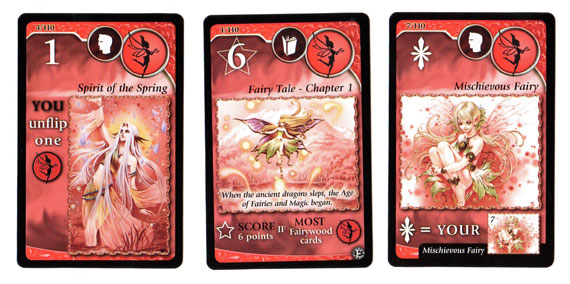
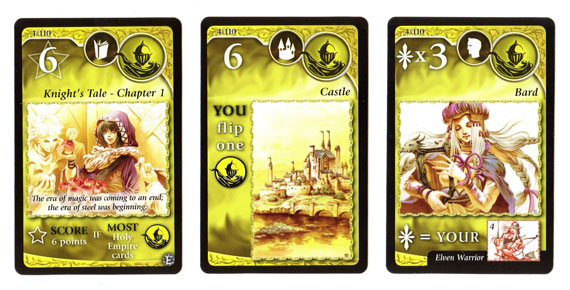
The whole point of all this drafting, flipping and un-flipping is to score points of course. There are several ways to do this. Some cards have a number on them and if they are face up at game’s end, you score that many points. Some cards have a fancy asterisk sort of symbol on them, and these cards are worth a number of points based on how many other cards of this type you have in play. Other cards pair with certain cards to multiply their score. And finally, cards with the “Fairy Tale – Chapter” title are worth bonus points if you achieve a certain goal. For example having the most Fairywood cards in play and so forth. Total all these various scoring combinations and if you played your cards right, you will emerge the victor!
Who would enjoy this game?
Final Thoughts
Pause if you will and consider the significance of the “combo.” You can get them in fast food. You can eat the pizza flavored kind, you can even finish someone off with one. (◄, ►, ►▼, B). But nowhere have they given the most enjoyment than in gaming – specifically card games (Ok, maybe in the finishing move listed above).
Fairy Tale is a game in which the goal is entirely dependent upon you creating card combinations – either during the card play phase or during the most important final scoring round. But what makes the game challenging is the element of drafting cards.
Drafting has been around for some time (in sports even longer) and using the element of choosing one card from a restricted set of cards and then passing those cards to your opponents adds two crucial elements to the game. First, as with all drafts, you know what cards will be in your opponent’s hands. (Surprise! They are the cards you didn’t choose.) Second, when choosing your card, you must decide whether to keep or give away certain cards that may be valuable to your opponents. In this way you can try to manipulate your opponents’ chances at winning or focus on building your own great scoring hand. Fairy Tale takes it one step further in that you only get to play 3 of the 5 cards you draft – forcing another choice in the card play phase. Your strategy may then deviate in reaction to other players’ cards.
But it all comes down to the combos. Card effects that affect other players’ cards may also give you an immediate advantage. But you can very quickly become the target next card play. Remember the cards you passed to you left?
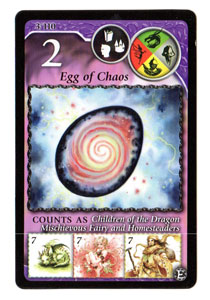
Satoshi Nakamura’sFairy Tale is ten years old and is now being rediscovered by a new throng of gamers as the hobby grows beyond geek culture in to the main stream. This version does include a new variant by some guy named Richard Garfield (Heh, what’s he know?), and a wild card of sorts called the “Egg of Chaos.” But the game is essentially the same gem that was published in 2004. Play once and gamers and non-gamers totally get it, and are ready to play again. The game is simple, elegant with amazing artwork by Yoko Nachigami and Chris Quilliams.
One final word of warning. Fairy Tale is not a story telling game or a story creation game. You can loosely make up small dramatizations as the cards interact with each other. Sure you can even give the characters funny voices. But really it’s a fast, card flipping, point scoring, combo love-fest.
User Reviews (1)
Add a Review for "Fairy Tale"
You must be logged in to add a review.

Fairy Tale is a card drafting game that plays very quickly and seats 2-5 players. I don’t have a lot of experience with drafting games but out of the ones I have played this is one of my favourites. Fairy Tale has been knocking all our other filler games off the table since we picked it up. What I like best about it compared to other drafting games other than the play / setup time is how the gameplay encourages you to draft to hinder your opponents. Read below for a quick explanation of how to play and my thoughts on how it scales between 2 and 5 players.
To read the entire review, complete with full sized image assisted explanations go to http://toddsboardgames.blogspot.ca/2014/05/fairy-tale.html
Objective / Goal:
The game is played in 4 rounds, at the end of the 4th round each player will have played 12 cards to create their own Fairy Tale. Players then score points depending on what cards each player has in their story
How To Play:
The game is broken into 2 phases, players will go through both phases in all 4 rounds. The first phase is the drafting phase and the later being the activation phase.
Drafting Phase:
In the drafting phase players will start with a hand of 5 cards, select 1 to keep for their hand and then pass the remaining cards to the player on their left. Continue to do this until you are each passed 1 card that you are forced to keep thus completing your hand of 5 drafted cards.
Activation Phase:
Players choose 1 of their 5 cards to play and wait until everyone else has selected their card. Then, at the same time everyone turns over their card revealing what they played.
Depending on the cards played, players may have the opportunity to perform actions that cause their own or their opponents cards to turn over (either face down so they are worth 0 points or face up to restore the loss of a face down card.)
After players have selected cards they both reveal them simultaneously.
Since this is the first card played, and the player has no other leaf cards they must turn the Fairy Ring face down.
Face down cards score 0 points at the end of the game.
During each activation phase players will only get to play 3 of their 5 cards, this is where I say Fairy Tale encourages you to screw with your opponents plans, the extra 2 cards you have should either be situationally better than the 3 cards you are planning on playing or simply taken to stop your opponents from gaining more of a set they are collecting.
Some cards allow you to turn a face down card face up, they have a green flip symbol.
The top row of shadow cards all allow you to turn one of your opponent’s cards face down.
Games End (Scoring):
After everyone has turned over their ninth card and executed any resulting actions, players get to total their points. Only cards remaining face up will count towards a players total points. I found the scoring simple, but a couple people I have shown it to find the scoring a bit confusing and there is definitely 1 icon that adds to the confusion (the ally).
Any card that has a number in the top left corner is worth that many points unless it has conditions that need met on the bottom.
All of these cards have conditions that need met, the leftmost needs you to have the most cards with statues on the top.
The red leaf card requires you to have the Fairy Queen. The leftmost green card requires you to have 2 yellow and 2 red leaf cards. And the rightmost card requires you to have the most Green cards at the end of the game.
Note: For cards that require majority a tie is good enough to score the points.
Any card with a star is worth a variable amount of points depending on the other cards you have face up at the end of the game. There are two types of variable scoring (star) cards.
The first work as multipliers for each other, if you have 1 it is worth 1 point each, if you have 2 they are worth 2 points each and so on. The most I have ever been able to get is 5 of these kind.
The other work with your Ally cards and are worth 3 points for each of the corresponding Ally card you have (who are worth a base 3 points themselves).
At final scoring, assuming this player had or was tied for the most books, they would score 33 points.
Homesteader’s are multipliers of themselves 3×3 = 9 points.
0 Points for the Leaf Fairy Tale Chapter since they did not have at least 2 green cards.
The dwarven warriors give 3x # of bronze dragons (1) = 3 points
And the remaining cards all score their face value = 21
How does it scale between 2 – 5 players?
Two Players: Surprisingly fun, I like drafting with just 2 players because its more of a head game, you have to think of what cards will make it back to you and weigh that as you consider which cards to take yourself and which to make sure your opponent will not get. 2 player Fairy Tale is a tense game but turns still go around quickly and the whole thing can be done in 5-10 minutes, definitely leaves you with a want to play again feel.
Three Players: For a lot of the reasons said above 3 player Fairy Tale is just as good as two player, I like it because each round you will have more options for strategy than in a two player game. The other major difference is there is there will simply be more cards to cycle through meaning the ones you want might turn up more often, still not enough for me to choose the King and Matching story cards as there are only 1 copy of each out of 100 cards. In a three player game 60 cards will be seen.
Four Players: This is where I start to consider using some of the more chancy cards, if you start with the King or Queen and not the story card I will take them every time as they are guaranteed points with a shot at very high points. I like how quickly turns the game plays with 4 players and I like how different your strategy needs to be from a 2 player game. In a four player game 80 cards will be seen.
Five Players: This is my least favourite number of players to play with, that being said I would still rather play fairy tale than a lot of other 5 player games. My reasoning is that turns go around quick but because it is played over 4 rounds and the cards you chose greatly effect the next round, you really feel like you are building towards / creating something. With 5 players I find people tend to focus more on their own Stories than screwing with other peoples because enough grey cards will come up that screwing with other people’s plans just kind of happens. 5 player is fun because you can come up with some really good strategies since the probability of seeing the cards you want / need is much higher than with any other number of players since every card in the deck will be used..
Who Would Enjoy Fairy Tale?
Family Gamers: There is no violence and once you have learned the iconography the game play is surprisingly simple. There is no long setup or explanation needed so you wont lose anyone’s attention. The game is over and done with in less than 15 – 20 minutes and there is no text that you need to read. Fairy Tale is really accessible while still having a cool theme, if fantasy doesn’t appeal to you then this is a game that you can very easily retheme and is worth doing so because it is a lot of fun to play.
Casual Gamers: Quick game play, easy to learn rules, no reading required and no long boring turns make this ideal to play with non gaming friends. That being said there is a lot of meta game involved in Fairy Tale which makes it easy to get into as more than just a filler and will leave your friends / group wanting to play again. Also because its a relatively inexpensive game its easy to justify adding a copy to your collection especially seeing as it is easy to bring with you somewhere.
Gamer Gamers: This is one I would encourage getting to play with your less serious friends. Even with the meta game there just isn’t enough meat for someone wanting to play a serious drafting game or even a game rich in fantasy theme. That being said it is really easy to teach and quick to jump right into and a fun game to bring to your local meetup and definitely satisfies the drafting itch.